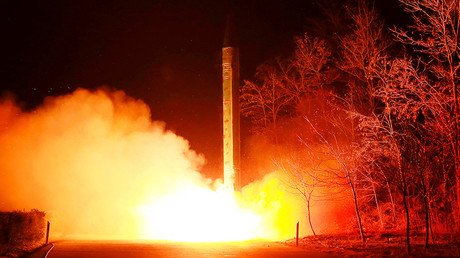N. Korea claims latest missile test ‘successful & proves its capability to carry nuclear warheads’
Pyongyang has claimed that its medium-range ballistic missile test carried out on Sunday under the supervision of Kim Jong-un has confirmed the “tactical specifications and technical characteristics” of the rocket which North Korea says is capable of carrying nuclear warheads.
North Korea has succeeded in launching its new surface-to-surface missile on May 14, Pyongyang’s official Central News Agency announced.
“The test fire was conducted with maximum angle of the projectile’s elevation in consideration of the safety of neighboring countries, with the aim of confirming the tactical specifications and technical characteristics of the new long-range strategic ballistic rockets capable of loading powerful heavy-weight nuclear warheads,” KCNA announced.
According to Pyongyang, the launch has enabled testing in “actual flight conditions” the missile’s “stabilization, structural, pressurization and launch systems,” as well as “reliability of the rocket’s engine” and its integrity “in the harsh reentry environment.”
“The launched rocket flew up to the maximum peak altitude of 2,111.5 kilometers along the scheduled flight orbit and precisely hit the target waters 787-kilometers away,” the communications ministry’s announcement read. The country's leader, Kim Jong-un, led the launch of a new type of rocket, the report noted.
More analysis is needed to verify North Korea's claim that it had successfully test-launched a ballistic missile, South Korea's military said following KCNA's announcement.
South Korea’s military also said earlier that the N. Korean projectile flew around 700 km before falling into the Sea of Japan. However, despite the North claiming it to be a long-range missile, the US military’s Pacific Command, which tracked and analyzed the launch earlier, said it was unlikely that the the fired projectile was an intercontinental missile.
“The type of missile is being assessed and the flight was not consistent with an intercontinental ballistic missile,” Pacific Command's spokesman said.
READ MORE: North Korean rocket flew away from Russia, was no threat – Russian Defense Ministry
The Russian Defense Ministry said the missile flew for 23 minutes before dropping in international waters in the central part of the Sea of Japan. While the projectile landed some 500 kilometers from the Russian coast, the missile test posed no threat to Russia, the military noted.
Kim Jong-un is in 'state of paranoia', US will continue ‘tightening screws’ on N. Korea - UN envoy Haley https://t.co/aLsJeunUzVpic.twitter.com/BZ8CCYB4Xe
— RT (@RT_com) May 14, 2017
After the White House said that North Korea has been a “flagrant menace for far too long,” US ambassador to the United Nations, Nikki Haley, said Washington will not negotiate with Pyongyang unless it stops its hostile actions.
“Having a missile test is not the way to sit down with the president because he's absolutely not going to do it,” Haley told ABC's ‘This Week’ when asked about conditions for President Donald Trump's meeting with the North's leader. “I can tell you, he can sit there and say all the conditions he wants. Until he meets our conditions, we're not sitting down with him.”
Late last month, Secretary of State Rex Tillerson said the Trump administration is open to direct talks with North Korea as long as the agenda is right. On Saturday, Choi Sun-hee, the North Korean diplomat who manages relations with the US, also hinted that Kim Jong-un might negotiate with Trump's team, “if the conditions are set.”
The latest missile test coincides with rising tensions in the region and a massive American military buildup there. In an attempt to deter Pyongyang from more nuclear and missile tests, the US has sent a group of American warships, led by an aircraft carrier, to the region. It has also been conducting war games with their regional allies. Last month, Washington also positioned elements of the THAAD anti-missile system on the Peninsula.













